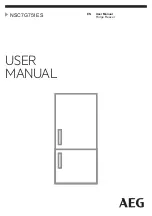
Troubleshooting table
Page EN-22
Troubleshooting table
Malfunctions can occur in all electrical appliances. This does not necessarily mean
there is a defect in the appliance. For this reason, please check the tables to see if you
can correct the malfunction.
WARNING
Risk of electric shock in case of improper repair!
Never try to repair a defective or suspected defective appliance yourself. You can put
your own and future users’ lives in danger. Only authorised specialists are allowed to
carry out this repair work.
Problem
Possible cause
Solutions, tips, explanations
Compressor off,
light off.
No electricity to socket.
Check the socket with another appliance.
Check the fuse.
Mains plug is loose.
Check the tightness of the mains plug.
Compressor off,
light on.
Temperature controller (11)
is set to ‘OFF’.
Turn the temperature controller to a higher
position (see “Setting the temperature” on
page EN-12).
Desired temperature has
been reached.
Further cooling not required. When the in-
side temperature increases, the compres-
sor automatically switches on again.
Appliance cools
too quickly.
The temperature controller
(11) is set too high.
Select a lower setting (see “Setting the
temperature” on page EN-12).
The appliance
doesn’t cool suffi-
ciently.
The temperature controller
(11) is set too low.
Select a higher setting (see “Setting the
temperature” on page EN-12).
Lid not tightly closed or lid
seal is not completely tight.
See ‘Checking and cleaning the lid seals’
on page EN-16.
The appliance is near a heat
source.
Place insulation plate between the appli-
ances or change location.
Food has been stored warm. Only store cooled foods.
Too many goods frozen.
The maximum freezing capacity is shown
on the type plate.
Ambient temperature too low
or too high.
Adjust the ambient temperature to the
climate category (see “Intended use” on
page EN-5).
Compressor seems defec-
tive.
Set the temperature controller to “6”. If the
compressor does not switch on within an
hour, please contact our service depart-
ment (see page EN-24).





































